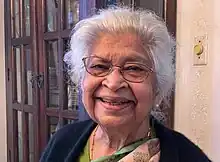Renu C. Laskar | |
|---|---|
 Renu Laskar | |
| Born | 1932 (age 91–92) Bihar, India |
| Academic background | |
| Alma mater | B. R. Ambedkar Bihar University, University of Illinois at Urbana-Champaign |
| Doctoral advisor | Henry Roy Brahana |
| Academic work | |
| Discipline | Mathematics |
| Sub-discipline | Graph theory |
| Institutions | Indian Institute of Technology Kharagpur, University of North Carolina at Chapel Hill, Clemson University |
Renu Chakravarti Laskar (born 1932) is an Indian-born American mathematician, specializing in graph theory. She is Professor Emerita of Mathematical sciences at Clemson University. She received her Ph.D. in Mathematics from the University of Illinois at Urbana-Champaign in 1962.[1] Renu Chakravarti Laskar's life was marked by a personal loss when her husband, Amulya L. Laskar, a distinguished professor of physics, died in 1991. His obituary in The New York Times recognized his contributions to physics and his role at the University of Missouri-Columbia.[2]
Laskar has often contributed to the theory of domination number and circular arc graphs. She wrote four papers with Paul Erdős, giving her an Erdős number of 1.[3]
Early life and education
Renu C. Laskar was born in Bihar, India. With the help of her family support, she finished her schooling and college, which wasn't much accessible to the women that time due to the cultural norms prevalent in India. It was during that time, when she discovered her talent for mathematics. Her pursuit of mathematics was influenced by her mother, who, after confronting the limitations of her own lack of formal education, learned multiple languages and advocated for her daughters' education. Laskar, not allowed to attend college due to her father's reservations, continued her studies at home with the assistance of tutors. She distinguished herself by scoring the highest in Bihar on her bachelor's degree examination. [4]
This led to a teaching offer at Ranchi Women’s College, and subsequently, a Fulbright Scholarship allowed her to travel to the United States in 1958. At the University of Illinois at Urbana-Champaign, she achieved her doctorate under the guidance of Roy Brahana and became the first Indian woman to do so at the institution. After earning her Ph.D., she married Amulya Lal Laskar, a physicist she met while studying in Illinois.[4]
She finished her Master's degree in Mathematics from B. R. Ambedkar Bihar University in the year 1955. Upon finishing college, Laskar, with strong encouragement from her elder brother, decided to come to the United States to pursue her Ph.D. in the year 1958. She worked for her Ph.D. degree at the University of Illinois at Urbana-Champaign under her advisor Henry Roy Brahana and received her degree in the year 1962. She is the first female Indian to receive a Ph.D. in Mathematics from UIUC. She returned to India after that and joined the Indian Institute of Technology Kharagpur as the first woman faculty at the institute. After three years, Laskar then moved back to the US at University of North Carolina at Chapel Hill and then finally joined Clemson University in the year 1968.[5]
Academic life
Laskar took full advantage of the opportunities she had and set new standards for women in mathematics. She ranks among the top women in discrete mathematics in the number of articles published. According to MathSciNet, she has over 100 publications. Part of the reason for her success in this area is her collaboration network, which included Raj Chandra Bose and Paul Erdős. She has extended her influence by supervising Ph.D. students. In 1986, Laskar and Steve Hedetniemi organized the Clemson University Discrete Math Miniconference, an event that has drawn an international audience each year since.[6]
Reflecting on her career, Laskar emphasized the value of academic relationships, both in her research and personal life, noting that many of her colleagues, including Erdős, were guests in her home. Her dedication to mathematics and education was accompanied by a fondness for teaching and the opportunity to mentor students and collaborate with peers. She has credited Clemson University with providing her a platform to excel and contribute to her field. [4]
References
- ↑ Renu C. Laskar at the Mathematics Genealogy Project
- ↑ "Amulya L. Laskar, 60, a Professor of Physics". The New York Times. 1991-07-22. ISSN 0362-4331. Retrieved 2023-11-07.
- ↑ "Erdös Number Project - The Erdös Number Project- Oakland University". oakland.edu. Retrieved 18 July 2015.
- 1 2 3 Landrum, Cynthia (2023-02-06). "Women in science: How 5 women with Clemson ties are making a difference". Clemson News. Retrieved 2023-11-07.
- ↑ "Renu Laskar: Changing Obstacles into Opportunities - AWM Association for Women in Mathematics". google.com. Retrieved 18 July 2015.
- ↑ "History of Mathematical Sciences at Clemson University". clemson.edu. Retrieved 18 July 2015.